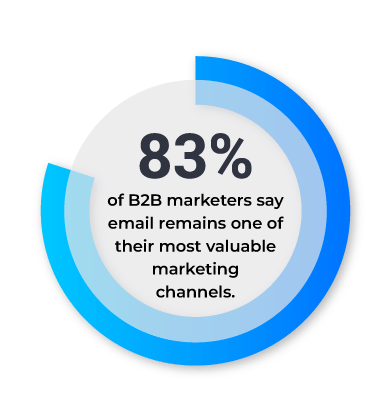Multichannel marketing is essential for reaching customers where they are. In today’s digital landscape, buyers engage with brands across multiple touchpoints—email, social media, websites, mobile apps, and even physical stores. Yet, while 95% of marketers recognize its importance, only 73% have a structured strategy in place. This gap presents a significant opportunity for businesses to refine their approach and drive better engagement. A well-executed cross-channel marketing strategy ensures consistent messaging, enhances customer experiences, and maximizes ROI. By strategically selecting and optimizing channels over time, businesses can achieve seamless integration and build meaningful connections. Let’s explore how to develop an effective multichannel marketing strategy that delivers real results.
What is Multichannel Marketing?
B2B multichannel marketing is a strategy that engages business buyers across multiple communication channels, both online and offline. Multichannel marketing refers to the practice of using a variety of platforms—such as email, social media, paid ads, websites, webinars, events, and direct mail—to reach and engage customers. Unlike traditional single-channel approaches, it enables companies to establish a unified brand presence across platforms.
The key advantage of multi channel digital marketing is its ability to reach decision-makers where they are most active. Since B2B purchase cycles are often long and involve multiple stakeholders, leveraging various touch points helps businesses stay top-of-mind and nurture leads effectively. However, simply being present on multiple channels isn’t enough. The most effective strategies ensure consistent messaging and a seamless customer experience, guiding buyers toward conversion without overwhelming them. The goal is to create a cohesive journey that aligns with the buyer’s preferences and behaviors. By integrating channels strategically, businesses can enhance visibility, boost engagement, and ultimately drive higher conversion rates. With the right approach, B2B multichannel marketing becomes a powerful tool for building relationships and accelerating sales cycles.
Essential Elements of B2B Multichannel Digital Marketing
A multichannel marketing strategy enables businesses to connect with their audience across multiple touchpoints, both online and offline. A successful integrated marketing approach integrates various platforms to deliver a seamless and consistent brand experience. One of its core elements is a well-optimized website, serving as the central hub where customers interact with the brand, explore products, and make purchases. Digital content platforms such as blogs, podcasts, and videos also play a key role in engaging audiences and driving traffic. Social media channels like LinkedIn, Twitter, and Instagram also allow brands to interact with customers in real time, build communities, and execute targeted advertising campaigns.
Email marketing remains a crucial component, offering personalized communication to nurture leads and enhance customer relationships. Offline channels, including physical stores, print media, and radio, continue to be valuable in multichannel strategies by complementing digital efforts and increasing brand visibility. When weighing multichannel vs. omnichannel marketing, brands should consider whether their current efforts deliver consistent experiences across channels or simply provide multiple options. Omnichannel marketing ensures that customer interactions are connected and context-aware—no matter the platform—while cross-channel marketing focuses on channel breadth.
A data-driven approach ensures that businesses optimize their marketing efforts based on audience insights and performance metrics. Personalization, consistent messaging, and seamless customer experiences further enhance engagement and conversion rates. By integrating these elements, businesses can create a cohesive marketing strategy that meets customers where they are and maximizes impact across multiple platforms.

Key Benefits of Multichannel Marketing for B2B
Embracing multiple channel marketing approaches is essential for modern businesses aiming to increase reach, engagement, and revenue while staying adaptable in an ever-changing landscape. Here are five key benefits of a multichannel marketing strategy:
Expanded Reach and Visibility
By diversifying marketing efforts across multiple channels—social media, email, search engines, and offline media—brands can connect with a broader audience. Different demographics prefer different platforms, and multichannel marketing ensures no potential customer is left out.
Higher Engagement and Conversions
Customers interact with brands across various touchpoints before making a purchase. A multichannel approach ensures consistent messaging, keeping your brand top-of-mind. Engaging customers through their preferred channels increases the likelihood of conversions and fosters long-term loyalty.
Improved Data Insights and Customer Understanding
With multiple channels in play, businesses collect valuable data on customer behavior, preferences, and interactions. These insights help refine marketing strategies, optimize ad spend, and create more targeted, personalized campaigns, leading to better outcomes.
Greater Marketing ROI and Efficiency
Multiple platforms of marketing allow businesses to allocate resources effectively by identifying high-performing channels. Automation streamlines processes like email follow-ups, retargeting, and personalized messaging, reducing manual effort while maximizing impact.
Adaptability and Competitive Advantage
Consumer behaviors evolve, and market trends shift. A multichannel approach provides the flexibility to pivot quickly, ensuring that marketing strategies remain effective and competitive. Businesses that engage across multiple platforms stay ahead of the competition and maintain strong customer relationships.
B2B Multichannel Marketing Plan: Essential Platforms for Success
A strong multichannel marketing strategy requires leveraging the right platforms to reach, engage, and convert target audiences effectively. Here are the essential platforms for success:
LinkedIn: The B2B Powerhouse
LinkedIn is the go-to market platform for B2B marketing, offering powerful networking, thought leadership, and lead generation opportunities. Sponsored content, LinkedIn Ads, and InMail campaigns help businesses engage decision-makers directly. One of the key multi channel marketing advantages is the ability to use LinkedIn alongside other platforms to create a unified, high-impact presence.
Email Marketing: Personalized and Scalable
Email remains one of the highest ROI-generating B2B marketing channels. Personalized email campaigns nurture leads, drive conversions, and maintain ongoing customer relationships. Automation tools like HubSpot, Marketo, and Mailchimp—key components of many multichannel marketing platforms—streamline email workflows for efficiency.
Search Engines: SEO & Paid Search
Google and Bing drive inbound leads through SEO and paid search ads. Optimizing website content with relevant keywords ensures visibility when potential customers search for solutions. Google Ads enhances reach with targeted PPC campaigns—illustrating how search fits into the multichannel marketing definition as a key digital touchpoint for reaching potential buyers.
Webinars & Virtual Events: Engagement at Scale
Hosting webinars on platforms like Zoom, GoToWebinar, or ON24 helps B2B brands educate audiences, demonstrate expertise, and generate high-quality leads. Interactive Q&A sessions and on-demand content boost engagement. These events play a strategic role in a multichannel marketing plan by creating direct, value-driven engagement opportunities.
Content Marketing: Blogs & Thought Leadership

High-value content—blogs, whitepapers, case studies, and industry reports—positions brands as trusted advisors. Publishing content on company websites, Medium, and LinkedIn enhances organic reach and authority. Many multichannel marketing platforms offer content distribution features to expand visibility and measure performance across channels.
Account-Based Marketing (ABM) Platforms: Targeted Outreach
ABM tools like Demandbase, Terminus, and 6sense enable hyper-personalized marketing to high-value accounts. These platforms integrate multiple channels—email, LinkedIn, and display ads—to engage decision-makers efficiently.
Key Elements for Multichannel Marketing Strategies
Creating a successful multichannel marketing strategy requires a customer-centric approach, ensuring that campaigns resonate with the target audience across various platforms. Understanding customer behavior, preferences, and touchpoints is essential for delivering value-driven interactions. Consistency is another key factor—aligning messaging, visual identity, and brand tone across all channels strengthens brand recognition and fosters trust. Additionally, leveraging marketing automation enhances efficiency, enabling personalized engagement while maintaining uniformity.
Personalization plays a crucial role in boosting customer engagement, using data-driven insights to tailor content, emails, and product recommendations. A data-driven strategy is vital for measuring and optimizing performance, allowing businesses to refine their approach based on real-time insights. Agility is equally important, as the digital landscape constantly evolves, requiring marketers to adapt to changing trends and consumer behaviors. Lastly, balancing resources across different channels ensures cost-effectiveness, maximizing return on investment while maintaining a broad yet strategic reach. By integrating these characteristics, businesses can drive impactful multichannel marketing campaigns that enhance engagement, conversion rates, and customer loyalty.
How to Build an Effective Multichannel Marketing Strategy?
Executing a successful multichannel marketing campaign requires careful planning, data-driven decision-making, and seamless execution. Marketers must strategically select the right platforms, craft compelling messaging, and continuously optimize based on performance metrics. Here are the key steps to building an impactful multichannel strategy.
Set clear objectives: Start by defining clear marketing goals that align with your business objectives. Establish key performance indicators (KPIs) to measure success, such as lead generation, customer engagement, or sales conversion rates. Having a well-defined goal ensures that every aspect of your multichannel strategy is purposeful and results-driven.
Understand your audience: A deep understanding of your target audience is crucial for multichannel marketing success. Conduct extensive market research to create detailed buyer personas that outline customer preferences, behaviors, and preferred channels. Leverage customer data to refine your approach, ensuring your messaging resonates with each audience segment.
Select the right channels: Not all marketing channels are equally effective for every business. Identify the platforms that best reach your target audience, such as social media, email, paid ads, SEO, or content marketing. Avoid spreading your resources too thin—focus on channels that yield the highest engagement and return on investment.
Develop consistent messaging: Your brand messaging should remain consistent across all marketing channels while being adapted to fit each platform’s format. This consistency strengthens brand recognition and trust. Ensure that your visuals, tone, and key messaging are aligned to provide a seamless and cohesive brand experience.
Personalize customer interactions: Customers expect personalized experiences across channels. Use marketing automation tools and AI-driven insights to deliver customized content, product recommendations, and targeted offers. Personalization in marketing enhances customer engagement, boosts conversion rates, and fosters long-term brand loyalty.
Integrate data and analytics: Data-driven decision-making is essential for multichannel marketing success. Utilize analytics tools to track performance across all channels, monitor customer interactions, and identify trends. By continuously analyzing your data, you can optimize multichannel marketing campaigns, refine targeting, and improve marketing effectiveness.
Optimize and iterate: A successful multichannel campaign requires ongoing testing and optimization. Conduct A/B testing strategies on ad creatives, email subject lines, and call-to-action placements. Monitor campaign performance, gather feedback, and make data-backed adjustments to improve engagement and maximize ROI.
Ensure seamless customer experience: A well-executed multichannel strategy should provide a smooth and integrated customer experience. Ensure that interactions between channels are seamless, whether a customer engages via social media, email, or your website. Streamline customer service and support across all touchpoints to enhance user satisfaction and drive brand loyalty.
Challenges in Multichannel Marketing and How to Overcome Them
By addressing these challenges proactively, B2B marketers can create a seamless, data-driven, and customer-centric strategy that drives engagement and conversions.
Messaging and Branding Consistency
Maintaining consistent messaging and branding across multiple channels is a common challenge in B2B marketing. Each platform has different content formats, audience expectations, and best practices. Inconsistent messaging can confuse potential customers and weaken brand recognition.
Solution: Establish clear brand guidelines covering tone, visuals, and messaging. Use centralized asset management tools and automation platforms to keep all content updated across channels. Regularly review and update messaging to maintain alignment.
Data Integration and Attribution
Multichannel marketing generates vast amounts of data, but integrating insights from different platforms can be complex. Marketers struggle to track which channels contribute to conversions, making it difficult to optimize multichannel marketing campaigns effectively.
Solution: Implement a robust marketing analytics and attribution model that tracks customer touchpoints. Use AI-driven analytics platforms to gain a holistic view of customer interactions and make data-driven decisions.
Customer Experience and Support

Providing a seamless customer experience across multiple touchpoints is challenging. Different platforms may have varying response times and service standards, leading to inconsistent customer interactions.
Solution: Create a unified customer support strategy by leveraging automation tools such as chatbots and CRM systems. Train support teams to maintain a consistent tone and approach across all platforms, ensuring a seamless buyer journey.
Resource Allocation and Budgeting
Balancing investment across multiple channels while maximizing ROI can be difficult. Some channels may yield higher returns than others, making budget distribution a critical challenge.
Solution: Continuously analyze performance metrics and adjust spending based on effectiveness. Prioritize high-performing channels while testing emerging ones. Use marketing automation to optimize resource allocation efficiently.
Agility and Adaptability
Market trends and customer behaviors shift rapidly, making it essential for B2B marketers to adapt quickly. A rigid strategy can lead to missed opportunities and declining engagement.
Solution: Foster an agile marketing culture by testing new tactics, analyzing trends, and iterating campaigns in real time. Regularly update strategies based on performance insights and evolving market demands.
Multichannel Marketing Examples
These cross-channel marketing success stories from Drift, Shopify, and IBM show how integrated campaigns can fuel brand authority, engagement, and growth. Here are the multichannel marketing examples:
- Drift used an account-based marketing (ABM) approach to position itself as a leader in conversational marketing. Their campaign integrated content marketing, influencer partnerships, events, and video. Marketing and sales teams shared data-driven insights, enabling personalized outreach through email, social, and direct channels. This alignment and consistent messaging drove higher engagement and qualified lead conversions.
- Shopify’s “Let’s Make You a Business” campaign targeted aspiring entrepreneurs across billboards, TV, and social media in key U.S. and Canadian markets. With consistent, motivational messaging like “Let’s make what you do for fun what you do for a living,” the multichannel campaign positioned Shopify as the top brand for turning side hustles into successful online businesses.
- IBM promoted Watson through blog posts, technical docs, and interactive demos across digital, social, and in-person channels like conferences. They mapped content to the buyer’s journey—educational at the top, case studies mid-funnel, and ROI-driven materials at the bottom. The marketing and sales teams collaborated closely, with live events and social content reinforcing Watson’s value.
Best Practices of Multichannel Marketing Strategies
To maximize multichannel outreach, focus on these key strategies for building your audience, respecting their preferences, and optimizing your communication for better results.
Grow your subscriber list by channel: To maximize multichannel outreach, start by expanding your subscriber base across platforms. Use customer touchpoints—like email sign-ups, online interactions, or point-of-sale moments—to collect preferences and permissions. Offer incentives like discounts or exclusive access to increase opt-ins. Always gather and record consent for compliance.
Ask for channel preferences: Let your customers choose how they want to hear from you. Some may prefer email for promotions, others SMS for reminders. Capture and store these preferences in your CRM or preference center. This enhances user experience and minimizes opt-outs by respecting personal choices.
Segment for better targeting: Use data to segment audiences and personalize campaigns. Leverage sign-up preferences, behavioral data, or cross-team insights to refine messaging. Smart segmentation avoids redundant outreach and ensures customers receive relevant messages via their preferred channel—boosting engagement and reducing opt-outs.

Define goals and conversions clearly: Set clear, measurable goals and define what counts as a conversion. Know how to track it—whether it’s a purchase, a form fill, or a click—and align those definitions across all channels. Use tools like link shorteners to track interactions on SMS or WhatsApp for accurate attribution and ROI analysis.
Optimize for cost and deliverability: Reduce spending by using only validated, engaged contact lists and preferred communication channels. Regularly clean your database and partner with reliable providers to ensure your messages reach the inbox or phone. Better deliverability equals higher engagement, lower costs, and improved ROI.
Future Trends in Multichannel Marketing
The future of multichannel marketing is being shaped by powerful technologies and evolving buyer expectations. Artificial intelligence (AI) and machine learning are at the forefront, powering predictive personalization and enabling marketers to anticipate prospect needs with precision. With data-driven storytelling, brands can craft messages that resonate on a personal level, shortening sales cycles and deepening engagement.
Generative AI is another game-changer—empowering teams to create campaigns, content, and assets at scale. By automating repetitive tasks, marketers can focus on strategy, creativity, and real-time optimization. Meanwhile, hyper-individualization is set to redefine customer journeys. Forget static personas—AI can now act on micro-signals like website behavior to deliver tailored content in real-time, such as case studies or webinar invites triggered by specific user actions. Emerging channels and connectivity will further fuel innovation. With 5G, augmented reality (AR), and virtual reality (VR), marketers can craft immersive experiences that blend digital and physical touchpoints. IoT devices will add new interaction layers, while blockchain may boost transparency and trust in digital advertising.
To stay ahead, B2B marketers must embrace agile, data-first strategies. Building an integrated tech stack, investing in advanced analytics, and collaborating with niche micro-influencers will be key. These influencers, with trusted voices in specific industries, help create authentic engagement and drive lead generation. As cross-channel marketing evolves, the brands that combine technology with creativity—while keeping the customer at the center—will lead the way in delivering impactful, personalized, and scalable campaigns.
Wrapping Up
Multichannel marketing is no longer optional—it’s a must for modern B2B success. When executed strategically, it enables businesses to deliver personalized, consistent experiences across the platforms their buyers use most. From enhancing brand visibility to nurturing leads and driving conversions, a strong multichannel approach aligns with today’s complex buyer journeys. Despite the challenges, companies that invest in data-driven strategies, marketing automation, and cross-channel consistency gain a competitive edge. By learning from successful brands and continuously optimizing tactics, marketers can turn each channel into a growth driver. The key lies in meeting customers where they are—with the right message, every time.




